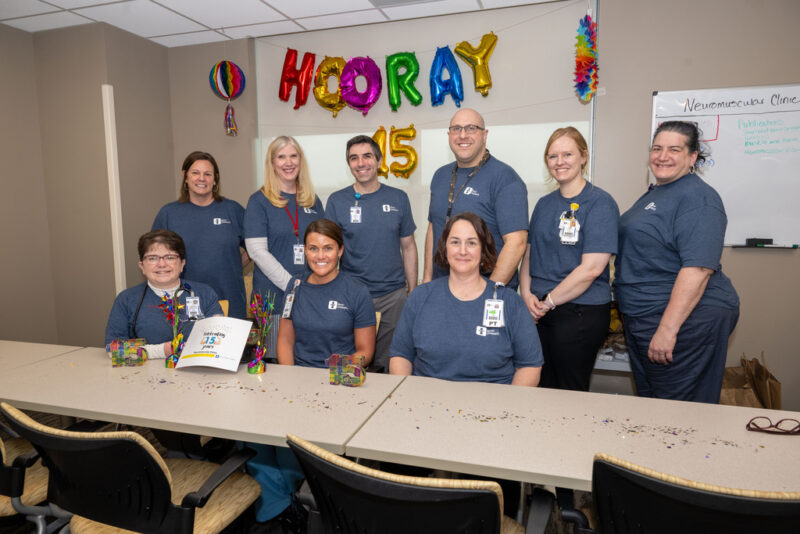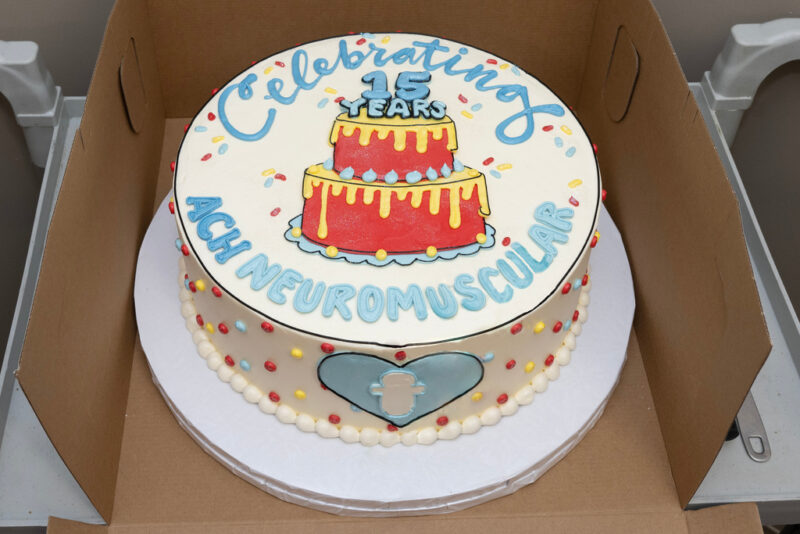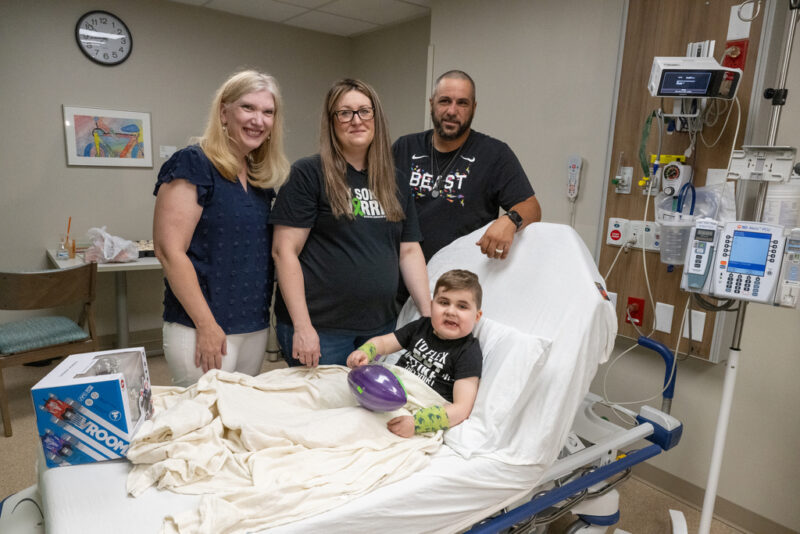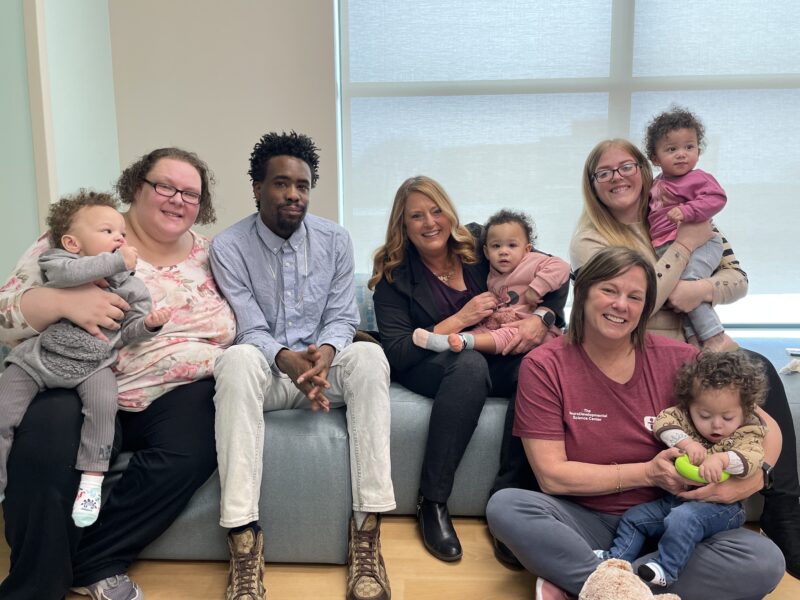
Some members of the Neuromuscular Clinic team gathered for lunch on Wednesday to celebrate their 15th anniversary.
Dr. Kathryn Mosher remembers a time when she had to explain to a parent what a diagnosis of spinal muscular atrophy (SMA) meant – and there was no hope to be offered.
“In the natural history of that disease, most children die by the age of two. If they do survive past that, they are very weak and typically dependent on a ventilator,” she said. “We could do little except to send these parents home to love their babies until they died.”
But, now since a gene therapy for SMA became FDA approved in 2019, Dr. Mosher and her team are seeing miracles: Toddlers with SMA are sitting up, crawling, walking, hitting milestones. They are not only surviving but thriving. The one-time infusion is not a cure but as close to one as possible and just one of several major advances in their field of pediatrics.
It’s brought feelings of “awe” and “privilege” to the professional lives of these providers who dared to dream of these days.
Akron Children’s Neuromuscular Clinic celebrated its 15th anniversary March 20 with a team lunch. They enjoyed cake, swapped gifts and enjoyed a multi-media presentation of clinical achievements.
The providers treat children with various forms of muscular dystrophy (Duchenne’s, Limb-Girdle, congenital), SMA, Charcot-Marie-Tooth disease, myotonic dystrophy, congenital myasthenic syndromes, Pompe disease, and McArdle disease among others.
The roots of the program began in 2006 when Dr. Mosher joined Akron Children’s as one of two pediatric physiatrists in what was then called the Neurodevelopmental Center (NDC). Division director Dr. Margaret McBride asked Dr. Mosher if she would be willing to create a multi-disciplinary neuromuscular program, which was identified as a gap in the hospital’s services.
“I accepted with great enthusiasm as this area was a personal passion of mine,” said Dr. Mosher, director of the Neuromuscular Program.
By 2008, Dr. Mosher had managed to recruit a small crew of physicians who shared her passion, and they began to meet monthly to design what the clinic should look like, including team members, clinic space, and the number of patients seen in a half-day clinic.
The group traveled to Nationwide Children’s Hospital to meet with Dr. Gerald “Jerry” Mendell and his team to look at its program. Dr. Mendell has five decades of experience in the field and his research led to breakthroughs in gene therapies for children with Duchenne muscular dystrophy.

The Neuromuscular Clinic has grown from seeing 4 patients to 230 a year and expansion of newborn screenings in Ohio will likely increase their volumes.
“With access to his invaluable and amazing mentorship, we launched our clinic in March 2009,” recalled Dr. Mosher. “We started as a half day clinic serving 4 patients once a month. Today, we run full-day clinics weekly serving more than 230 patients per year. Our current team includes specialists who are dedicated to high quality care for this population including: physiatry, neurology, cardiology, pulmonology, endocrinology, orthopedics, palliative care, physical therapy, occupational therapy, social work and a nurse coordinator.”
Akron Children’s has been at the forefront of innovation in the care of patients with neuromuscular disorders with such notable achievements as:
- The first in state to deliver the first FDA approved disease modifying therapy for Duchenne muscular dystrophy (DMD) known as Exondy 51 in 2016.
- The second in the world to deliver the gene therapy for DMD known as Elevidys after its FDA approval in June 2023.

In August, 2023, 5-year-old Vinnie DeMando became one of the very first children in the world to receive the new FDA approved gene therapy, Elevidys, for Duchenne muscular dystrophy at Akron Children’s.
“We have experience with all the currently FDA-approved therapies for neuromuscular disorders, and we are involved in clinical trials of new therapies in development,” said Dr. Mosher. “We also enjoy a unique collaboration with centers throughout the state of Ohio, tracking the impact of these therapies on our patients.”
In 2019, Akron Children’s was recognized by Parent Project Muscular Dystrophy as a Certified Duchenne Care Center and, in 2021, became a Muscular Dystrophy Association Affiliate.
“We are very excited about the potential of the new newborn screen for Duchenne muscular dystrophy in the state of Ohio signed into law by Gov. Mike DeWine, taking effect this month and its potential to transform our ability to care for these patients,” said Dr. Mosher.
“In our 15 years we have literally watched history being rewritten on some of these diseases, and we look forward with enthusiasm to the further progress to come,” she said.

Monica Robins, senior health correspondent at WKYC TV in Cleveland, recently did a story about Akron Children’s Neuromuscular Clinic and the hope given to two sets of twins with SMA. A link to the story is below.











